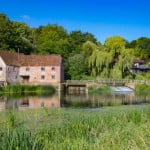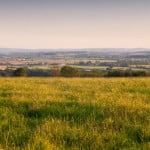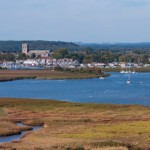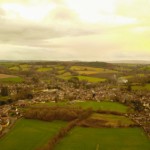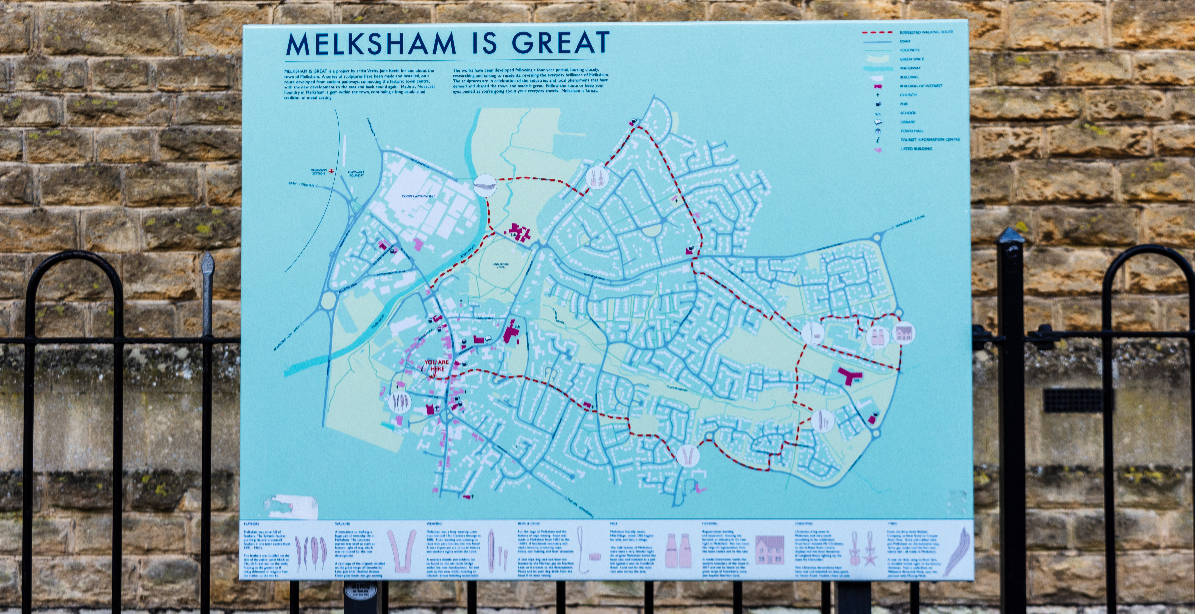
Melksham is a market town and civil parish in west Wiltshire, southwest England. Situated on the River Avon, its about 5 miles (8 km) north-east of Trowbridge and 6 miles (10 km) south of Chippenham. It’s the fifth biggest settlement in Wiltshire by population after Swindon, Salisbury, Trowbridge and Chippenham. The town has a strong tradition of agriculture, especially dairy farming, and historically, the woollen cloth industry. At the 2011 census, the town of Melksham had a population of 19,357.
A Fleeting Melksham History
The original Saxon settlement of Melksham developed at a ford crossing of the River Avon. With the area being renowned for its farming and pasture land it is thought that the name Melksham is derived from Meolcham, where ‘Meolc’ was the old English name for ‘milk’, and ‘ham’ meaning settlement. At the time of the Norman Conquest of 1066 Melksham was part of a royal estate and forest.
The Domesday Book of 1086 recorded that Melksham had 8 mills, and that the population of several hundred, included 189 landowners, 19 ploughmen and 35 serfs. In 1219, Melksham was granted a charter by Henry III to hold a weekly Friday market and a fair on Michaelmas Day (29th September). In 1250, a further charter saw a Tuesday Market and the Michaelmas Fair being upped to a 3-day event. Life of the time in Medieval Melksham was almost certainly centred around Church Street, Church Walk, High Street and Market Place.
By the middle of the 14th century, Melksham was already a weaving town, with its spinners, weavers, fullers and shearmen, mostly producing undyed broadcloth. The wool came from the North Wiltshire and the Cotswolds and while the finished cloth was sold initially sold in London, later it went all over England and was even exported to the Continent. In 1415, it is mentioned on record that parishioner William Honeston, bequeathed a sum of money for maintenance of the town’s bridge. Thus, it would seem likely that the first structure built at the site of today’s Town Bridge was in the 14th century but perhaps even earlier.
In 1491, the Prioress of Amesbury, who had held the Melksham manor since the late 12th century, a privilege granted by Henry II, obtained a charter to hold a two-day annual fair in the town during July. By the early 1600s, the once great royal forest around Melksham had but disappeared with the land being tenanted for agricultural purposes.
The Civil War
In the mid-17th century, the woollen trade was severely disrupted by the English Civil War, as Cromwell imposed a veto on the importation of cloth into London. However, the industry recovered and thrived after the second war ended in 1651, when the town began producing coloured cloth. Though, by 1726, the piece rate paid for cloth production was so low that it became impossible for weavers to earn a living.
An application made to the town authorities for financial assistance was refused, which resulted in riots and troops being called in to disperse the protesters. Even by 1739, there had been little change in the fortunes of those working in the wool industry, which resulted in more protests. The town’s premier clothier, Henry Coulthurst had his house ransacked, his mills damaged, his cottages destroyed, and large quantities of wool thrown into the River Avon. The three rebel ringleaders were tried, found guilty on charges of sedition, and then hanged.
In 1750, the toll road route between London and Plymouth was rerouted to pass through Melksham. This meant stagecoach travellers from the capital on their way to Bath, Bristol, Exeter and Devonport often sought lodgings in the town. The town continued to prosper on the back of its improved connectivity and other industries moved into the town.
Around 1770, a natural spring was discovered on the road to Devizes from Melksham. By the early part of the 19th century its water was being promoted as having properties to cure various ills. In 1815, the Melksham Spa Company was formed and with the appropriate buildings being erected in an attempt to rival nearby Bath. While people did come to take the waters for a little while, the town could not match the splendours of fashionable Bath, meaning Melksham’s Spa was always doomed to failure.
C. W. Maggs & Company
In 1803, C. W. Maggs & Company, manufacturers of mats, rope and twine, opened business at Spa Road. Also early in the 19th century, the production of cheese became important to the town. In 1810, the Wilts & Berks Canal was opened, meaning it became much easier to bring in raw materials and ship out finished goods to/from the town, via the local Kennet and Avon branch canal. Thus, having the asset of the new waterway brought even more business to the town.
Nevertheless, the town’s wool industry still went into decline. Such that, by 1838, there were only two cloth mills left in Melksham, which were employing about 160 workers. In 1848, the Wilts, Somerset & Weymouth Railway came to Melsham to the detriment of the local canal’s profitability but greatly improving connectivity with the surrounding area and the rest of the country.
In 1870, the Post Office Telegraph Service was introduced to the town. In 1888, the last working cloth factory, Matravers Mill, was closed and sold-off at auction. The following year saw the Avon India Rubber Company move from Stoke to set up shop at the site of the old mill. It produced a number of rubber goods until it was taken over by the American tyre company Cooper at the turn of the century. Today, Cooper Avon Tires is still one of the largest employers in Melksham.
In 1897, the eponymous grandson of the ropeworks founder Charles Maggs, founded a dairy company that became the Wilts United Dairy Company in a merger of 1915. In 1898, the National Telephone Company replaced the telegraph service and the Trowbridge Water Company provided the town with its first public water supply. The turn of the 20th Century also saw dairy farming continue to expand as a major local industry. Subsequent job opportunities saw both the local population and housing increase in equal measure.
In 1919, a war memorial was unveiled in Canon Square that revealed the names of the 105 local servicemen who had fallen in the Great War. In 1940, the onset of WW2 saw RAF Melksham open at Bowerhill, as a School of Technical Training. After WW2, a further 46 names were added the town’s war memorial. In the late 1950s, the town’s diary company merged once again to form Unigate, a company that was to became one of Britain’s biggest food manufacturers.
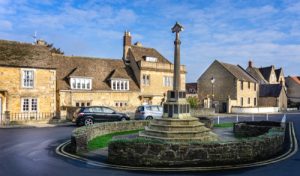
Melksham’s War Memorial. Photo – Nigel Jarvis/Shutterstock.com
The Modern Era
Like most places, many of Melksham industries from the early part of the century have now disappeared, but have been replaced by smaller and more varied enterprises. One business that has stood the test of time in Melksham is tyre production. However, in 2019, Cooper Avon Tires cut its workforce of 730 by more than 300, transferring production to Serbia. However, Melksham’s strategic location on the A350, means that it has not only become a popular location for business but a gateway for tourists who want to explore the Wiltshire countryside.
In 1965, RAF Melksham closed with the abolition of national conscription. Today, Bowerhill is a thriving community, which has over 1,000 houses, together with shops, a primary school, a sports centre and a trading estate, which accommodates an eclectic mix of more than 100 companies.
Some of the major dates in the Melksham calendar include the Easter Scarecrow Trail, and the summer held events of the Melksham Food River Festival, Melksham Carnival and the Party in the Park. There’s also the popular Melksham Christmas Fayre, which you can expect to have all the usual trimmings. The Melksham Comic Convention is also usually held during the summer months, with the last one taking place in 2018, but its future remains uncertain.
Getting to Melksham
So you find yourself in Wiltshire and fancy paying the town a visit? Well let us guide you there.
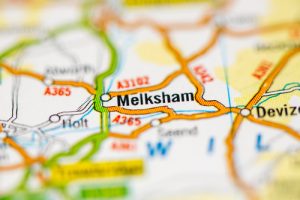
Image: SevenMaps/Shutterstock.com
By Road
Melksham is about 10 miles (16 km) from junction 17 of the M4. From there take the A350 which runs from the M4 to Poole on the Dorset coast.
By Train
The average journey time between London Paddington and Melksham is around 2 hours 30 minutes, with around 17 trains making the trip per day. The local train service which serves nearby Trowbridge, Chippenham and Swindon is operated by TransWilts. Nearby Trowbridge is a stop on the Wessex Main Line between Bristol and Southampton.
By Coach
There’s an average of 3 direct coaches per day between London Victoria and Melksham, which are operated by National Express. The journey usually about 3.5 hours with all buses usually leaving London around 7 am. From many parts of the country, it’s probably best to head to Bristol and change for the town from there.
By Air
The nearest airport is Bristol, which is 31 miles (50 km), via the shortest road route of the A39, A4 and A365.
Notable people
- John Fowler (1826 – 1864) – was an agricultural and drainage engineer who was a pioneer in the use of steam engines within his field. He was born and lived in Melksham until early adulthood.
- Edmund Wright Brooks (1834 – 1928) – was a renowned Quaker and philanthropist. He was active in the Anti-Slavery movement, instrumental in famine relief to Russia and bringing aid to Armenia in the early 1900s. Fowler was born here and lived there until his mid-teens.
Did you know?
Sidney Leslie Goodwin, a 19-month-old child, sadly achieved a touch of notoriety as being the youngest victim recovered after the sinking of the RMS Titanic. However, for almost 100 years his gravestone in Fairview Cemetery, Halifax, Nova Scotia, Canada read “Erected to the memory of an unknown child whose remains were recovered after the disaster to the Titanic April 15th 1912”. For many years, the body was thought most likely to be that of fellow third-class child passenger Eino Viljami Panulato. However, in 2007, DNA testing conclusively identified the child’s remains as that of Sidney Leslie Goodwin, who was born in Melksham on 9 September 1910. Sidney’s parents and five siblings, all perished with the sinking of the Titanic.
Sport in Melksham
Melksham Town FC
Melksham Town FC is an amateur team that currently (2020) play in the Southern League Division 1 South. Nicknamed ‘Town’, they play their home games at Oakfield Stadium.
Melksham RFC
Melksham Rugby Football Club currently (2020) play in the Southern League Division 1 South. They play their homes games at the Oakfields complex.
Melksham Cricket Club
Melksham Cricket Club’s currently (2020) play in Division 4 of the Wiltshire County Cricket League. They play home games at the Melksham House Ground.
Things to do & See in Melksham
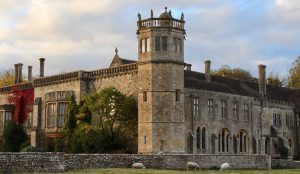
Image: Nathalie Saint-Martin/Shutterstock.com
You will not be stuck for things to do on your visit. Some of our favourites things are:
- Vintage Classics – is a car hire company based in Melksham that’s popular with classic car enthusiasts. If you’ve ever wanted to drive an E-Type Jag, Aston Martin or Austin Healey and the likes – this is your big chance! The company provide route maps of the best things to see in the area while you’re living the dream.
- Lacock Village – is four streets of a preserved 18th-century village owned by the National Trust. The village, which is located less than 2 miles from Melksham, has provided a shooting location for some of the Harry Potter films, Downton Abbey, a BBC adaption of Pride and Prejudiced, and others
- Fox Talbot Museum – can be found in the grounds of Lacock Abbey and is dedicated to the memory of William Henry Fox Talbot (1800-1877). Arguably the Abbey’s most famous resident, Talbot is renowned for his contribution to photography. The various displays at the museum are centred around Fox’s life’s work.
- Great Chalfield Manor – is a medieval manor house, built in the late 15th century which features a gatehouse, moat and defensive wall. It’s rated as one of the most picturesque and best-preserved medieval manors in England. There’s also formal gardens with terracing, manicured hedges and topiary trees and shrubs.
- Kennet and Avon Canal – runs for 87 miles between Reading and Newbury, roughly following the course of the River Avon. Should you fancy a day (or even a week) on the canal you can hire a narrowboat at Tilperton Marina less than 4 miles from Melksham.
- Lacock Abbey – is a quirky country house with monastic roots. It’s been extended several times so been built in various architectural styles but dates back to the 13th century. It’s located in the centre of Lacock village, set in its own woodland grounds on the banks of the Avon. The Abbey has various art displays and exhibitions. There’s also a shop and cafe on site.
Where to stay?
There’s a very limited amount of accommodation in Melksham itself. Staying in Chippenham (4 – 5 miles) or Bradford on Avon (4 – 5 miles) or the numerous close-by villages will give you more options. A rough guide to prices for 2 adults sharing, staying in the general area of Melksham is £70 – £150 per night for either a guesthouse or hotel, depending on standard and location.
Moving to Melksham?
Thinking of moving to Melksham? The average selling price for all property in Melksham for the year up to August 2020 was approximately £271,900. This represents a rise of about 2% on the previous 12 months. In terms of property types, flats sold for £126,000, terraced houses for £205,000 and semi-detached for £241,500.
